Email collection is a vital component for any website owner looking to build a relationship with their audience. Whether you’re running a blog, an e-commerce site, or a service-based business, capturing emails allows you to engage with your visitors, share updates, and promote your offerings. In the world of WordPress, gathering email addresses can be streamlined, efficient, and user-friendly. Let’s delve into some effective methods and tools available for gathering those precious email addresses using form plugins!
Why Use Form Plugins for Email Collection?

So, why should you consider using form plugins to collect emails on your WordPress site? The answer is simple: they make the process so much easier and more effective! Here are some compelling reasons to use form plugins:
- User-Friendly Interface: Form plugins usually come with an intuitive drag-and-drop functionality, which means you don’t need to be a coding whiz to set them up.
- Customizable Forms: You can easily customize your forms to match your branding, including various fields like name, email, phone number, and even dropdowns!
- Integration with Email Marketing Services: Many form plugins integrate seamlessly with popular email marketing platforms like Mailchimp, Constant Contact, or ConvertKit. This makes managing your contacts a breeze.
- Spam Protection: Many plugins come with built-in spam protection features such as CAPTCHA or honeypot fields to keep your email list authentic and clean.
- Analytics and Tracking: Some form plugins offer insights into form submissions, so you can measure performance and optimize your strategies.
Using form plugins not only simplifies the email collection process, but it also enhances user experience, making it more likely that visitors will willingly share their email addresses with you!
Choosing the Right Form Plugin for Your Needs

When it comes to selecting a form plugin for your WordPress site, the choices can be overwhelming. With a myriad of options available, you may wonder: which one is the right fit for you? Here are some key factors to consider to make the right choice:
- Functionality: Think about what you need the form to do. Do you want a simple contact form or a more complex form that allows file uploads, or maybe even payment processing? Some plugins specialize in certain functionalities.
- User Experience: A friendly user interface (UI) can save you a lot of headaches. Look for plugins that are easy to use, even for beginners. You don’t want to spend hours figuring things out!
- Customization Options: Consider how much control you want over the look and feel of your forms. You may need different design options to match your website theme or branding.
- Integration Capabilities: If you plan to connect your forms to other tools, it’s crucial to check whether the plugin integrates seamlessly with them. Popular options include email marketing software and CRM systems.
- Support & Updates: A reliable plugin should come with good support, whether it’s through a help center, forums, or direct assistance. Also, check how often the plugin is updated to ensure compatibility with the latest WordPress version.
By evaluating these factors, you can pinpoint the form plugin that aligns best with your site’s needs and enhance the communication with your visitors effectively.
Step-by-Step Guide to Setting Up a Form Plugin
Now that you’ve chosen the right form plugin for your WordPress site, it’s time to get it set up. Don’t worry; it’s simpler than you might think! Follow this step-by-step guide to aid in your installation process:
- Install the Plugin:
Head over to your WordPress dashboard, go to Plugins, and click on Add New. In the search bar, type the name of your chosen form plugin, and click Install Now. Once it’s done, click Activate.
- Create Your First Form:
After activation, you’ll typically find the plugin in your dashboard menu. Click on it and look for an option to create a new form. Most plugins offer templates that you can customize.
- Customize Your Fields:
Drag and drop the fields you want (like name, email, message) to create your desired form layout. Don’t forget to enable validation for email addresses or phone numbers where applicable.
- Set Up Notifications:
Decide how you want to be notified when someone submits a form. Go to the settings of the plugin and input the email address where you want the submissions to go.
- Embed the Form:
Most plugins offer a shortcode you can easily embed in your pages or posts. Just copy the code and paste it where you want the form to appear.
- Test Your Form:
Before going live, make sure to submit a test entry yourself to verify that everything works as expected. Check if you receive the notification and if the data appears in the backend.
And voilà! You’ve successfully set up your form plugin. With forms up and running, you’re well on your way to connecting with your audience better.
Customizing Your Email Collection Form
When it comes to collecting emails through your WordPress site, customizing your email collection form is key. A well-designed form not only attracts visitors but also encourages them to subscribe. Here are some tips to help you get the most out of your form customization:
- Choose the Right Fields: Keep your form simple. Ask for essential information only, like the subscriber’s name and email address. You might want to include fields like phone number or location, but too many fields can overwhelm visitors. The optimal number of fields is usually between 2-4.
- Compelling Call-to-Action: Your submit button should entice users to click. Instead of a plain “Submit,” consider something more engaging like “Join Our Community” or “Get Your Free Guide!”
- Design that Stands Out: Use colors that stand out but also complement your overall website design. This way, the form catches the eye of your visitors. Don’t forget to consider mobile responsiveness, as more users access sites via phones these days.
- Incorporate Visuals: Adding a relevant image or icon can make your form more appealing. Think about using an inviting photo of a happy customer or creative graphics.
- Privacy Assurance: Make sure to reassure users that you value their privacy. Include a simple note like “We respect your privacy. No spam, ever!” or link to your privacy policy.
Ultimately, the goal is to create a user-friendly experience that prompts visitors to share their email addresses voluntarily. Your form is your first interaction with potential subscribers, so make it count!
Integrating the Form with Email Marketing Services
Integrating your email collection form with email marketing services can significantly boost your communication strategy. By linking these tools, you ensure that every email address collected is automatically added to your mailing list—saving you valuable time and minimizing errors. Here’s how to seamlessly integrate your form:
- Select Compatible Plugins: Ensure your form plugin is compatible with your email marketing service. Popular services like Mailchimp, Constant Contact, and ConvertKit have plugins or integration features that make this process straightforward.
- API Keys and Authentication: Most email marketing services require you to enter API keys for integration. Access this in your service’s settings and ensure you copy it accurately. It acts as a bridge between your WordPress site and the email platform.
- Customize Email Lists: After setup, specify which email lists your subscribers should be added to. For instance, you might have different lists for newsletters, promotions, and announcements. This creates a targeted approach in your email campaigns.
- Double Opt-In: Consider setting up a double opt-in process, where subscribers must confirm their email addresses before being added to your list. This can improve the quality of your email list by ensuring subscribers genuinely want to receive your content.
- Test the Integration: Before launching your form, run a few tests to confirm that emails are properly funneling into your email marketing service. Subscribe using a test email and ensure everything functions as expected.
Integrating your email form with marketing services not only streamlines your data collection but also enhances your capabilities to engage with subscribers effectively. The right setup can help you build a meaningful relationship with your audience right from the start!
7. Best Practices for Collecting Emails Effectively
Collecting emails is a crucial part of building and maintaining an audience for your WordPress site. However, it’s not just about grabbing as many emails as possible; it’s about doing it effectively and respectfully. Here are some best practices to help you collect emails while keeping user experience in mind:
- Use Clear Call-to-Actions (CTAs): Make sure your CTAs are visually appealing and stand out. Phrases like “Join our newsletter” or “Get your free eBook” clearly inform users about what they will receive by signing up.
- Offer Value: People love receiving something in return for their contact information. This could be a discount, exclusive content, or an eBook. The more value you provide, the more likely people will opt in.
- Keep It Simple: Don’t overwhelm users with long forms. Generally, asking for just an email address is sufficient. The less you ask for, the higher your conversion rate.
- Reassure Users: Transparency is vital. Let users know how their emails will be used and reassure them that their information is safe. A small note stating, “We respect your privacy,” can go a long way.
- Follow Up: After users submit their emails, send a thank-you message or a welcome email. This not only shows appreciation but also establishes a positive relationship from the get-go.
Implementing these best practices can lead to a more effective email collection strategy that builds trust with your audience while maximizing your numbers.
8. Testing and Optimizing Your Email Collection Form
Testing and optimizing your email collection form is an ongoing process. Just because a form worked yesterday doesn’t mean it’ll work tomorrow. Here’s how you can keep improving it:
- Track Performance: Use analytics tools to monitor how well your forms are performing. Look at conversion rates and see how many users are actually completing the form.
- A/B Testing: Changing one variable at a time can help you discover what works best. Test different headlines, CTA buttons, or even the position of your form. Keep track of your results to find the most effective combination.
- User Feedback: Don’t hesitate to reach out to your users. Ask them if they found the form easy to use. Their feedback can be invaluable for improvements.
- Mobile Optimization: Given that many users access websites via mobile devices, it’s critical to ensure that your forms are mobile-friendly. Always test your forms on different devices.
- Reduce Friction: Make the form as straightforward as possible. Even small changes like adjusting the font size or line spacing can significantly enhance user experience.
By continuously testing and optimizing your email collection form, you can create a more intuitive experience for users, ultimately leading to increased sign-ups and engagement.
Conclusion and Next Steps
In conclusion, leveraging form plugins to capture emails in WordPress is an essential strategy for building your audience and enhancing your communication with visitors. By implementing a form plugin, you can easily gather leads, feedback, and other valuable information that can be instrumental in your website’s growth.
Here are some key takeaways and next steps to consider:
- Select the Right Plugin: Choose a form plugin that suits your needs, such as WPForms, Elementor Forms, or Contact Form 7.
- Customization: Customize your forms to align with your branding and ensure a smooth user experience.
- Email Marketing Integration: Integrate your forms with popular email marketing services like Mailchimp, ConvertKit, or AWeber to streamline your email campaigns.
- Test Your Forms: Regularly test the functionality of your forms to ensure emails are being captured correctly and there are no glitches that could hinder user submissions.
- Monitor and Analyze: Utilize analytics to track form submissions, understand user behavior, and make adjustments to improve conversion rates.
By following these guidelines and continuously improving your approach, you will be well on your way to effectively capturing emails and enhancing your WordPress website’s functionality.



